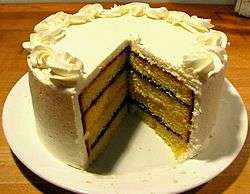Princess cake
|
A small green princess cake served at IKEA in Minnesota | |
| Alternative names | Prinsesstårta, Grön tårta |
|---|---|
| Type | Cake |
| Place of origin | Sweden |
| Creator | Jenny Åkerström |
| Main ingredients | Sponge cake, whipped cream, pastry cream, marzipan, powdered sugar |
|
| |

A princess cake (prinsesstårta in Swedish) is a traditional Swedish layer cake or torte consisting of alternating layers of airy sponge cake, pastry cream, and a thick-domed layer of whipped cream. This is topped by marzipan, giving the cake a smooth rounded top. The marzipan overlay is usually green, sprinkled with powdered sugar, and often decorated with a pink marzipan rose.[1][2]
The original recipe first appeared in the 1948 Prinsessornas Kokbok cookbook, which was published by Jenny Åkerström, a teacher of the three daughters of Prince Carl, Duke of Västergötland.[3] The cake was originally called grön tårta (green cake), but was given the name prinsesstårta or "princess cake" because the princesses were said to have been especially fond of the cake. The princesses were Princess Margaretha (1899–1977; later Princess of Denmark), Princess Märtha (1901–1954; later Crown Princess of Norway), and Princess Astrid (1905–1935; later Queen of the Belgians).[4] The cake is widely featured in Tom McNeal's book Far Far Away.
Variations
Variants with other colours of marzipan are occasionally called prinstårta (prince cake) for blue marzipan and operatårta (opera cake) for red or pink marzipan.
See also
- Swedish cuisine
- Frog cake, a broadly similar Australian dessert
- List of cakes
References
- ↑ "Royal Dilemma: Why is the Princess Cake Green?". 2008-11-12. Retrieved 2012-08-20.
- ↑ Vera (2009-02-24). "Swedish Princess Cake". Retrieved 2014-01-26.
- ↑ "Princess cake demystified (prinsesstårta)". 2011-09-21. Retrieved 2015-05-31.
- ↑ "Traditionsenlig tårtfrossa - Prinsessyra bäddar för prinsesstårtans vecka" (in Swedish). Cisionwire. 2009-09-17. Retrieved 2009-12-19.

